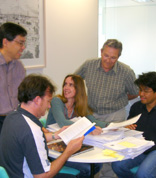Intellectual Property Policy
To analyse the economic costs and benefits of compelling competitors to recognise patent rights at differing stages of the innovation process. Broadly speaking, the trade-off is as follows:
Stringent ex ante recognition of monopoly rights at the time of examination. This means high costs of examination but it will minimise rent-seeking behaviour (since obvious inventions wont be recognised).
An undemanding examination threshold but stringent ex post recognition in court. In this case, costs are shifted towards the courts but a vastly smaller number of patents incur these costs.
We expect higher levels of rent-seeking behaviour to occur under this scenario. The method will include a review and analysis of the literature with some additional empirical work from the IP Australia data base.
Papers from this project include:
- Paul H. Jensen, Alfons Palangkaraya, Elizabeth Webster and Jongsay Yong (2008) The Effect of Raising the Australian Statutory Inventive Step on the Australian Global Production System PDF Format (214 KB)
- Chris Dent, Paul Jensen, Sophie Waller and Beth Webster (2006) Research Use of Patented Knowledge: A Review PDF Format (571 KB)
- Paul H. Jensen and Elizabeth Webster, Factors Affecting the Power of Patent Rights, PDF format (121K), published as Australian Economic Review , 37(4), 419-426. Reprinted in Melbourne Legal Studies, (forthcoming).
- Paul H. Jensen and Elizabeth Webster, SMEs and Their Use of Intellectual Property Rights in Australia, PDF format (342K). Published as Jensen, P. H. and Webster, E. (2006) Firm size and the Use of Intellectual Property Rights, Economic Record. March
For further information on these papers or the data sets used please contact Professor Elizabeth Webster on [email protected].

Industrial Economics team members
